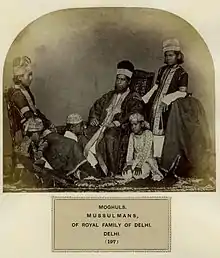Mughal people
The Mughals (Persian: مغول; Hindustani: मुग़ल/مغل, also spelled Moghul or Mogul) are a number of culturally related clans of India and Pakistan.[1] They claim they are descended from the various Central Asian Mongol[2][3] and Turkic tribes that settled in the region.[1] The term Mughal (or Mughul in Persian) literally means Mongolian.[4]
 A photo from The People of India, published from 1868 to the early 1870s by W. H. Allen Ltd, for the India Office. | |
| Regions with significant populations | |
|---|---|
| India, Pakistan | |
| Languages | |
| Hindustani (Urdu-Hindi) Persian (formerly) | |
| Religion | |
| Islam | |
| Related ethnic groups | |
| Moghols, Mongols, Turks |
History and origin
During the time of the Mongol Empire in the 13–14th century, the army of Genghis Khan swept across Central Asia and into Persia. Over subsequent centuries, descendants of these soldiers inter-married with Persian and Turkish Muslims, converted to Islam, and adopted the Persian language and culture. Conflict between India and the Mongols has been recorded from the time of Genghis Khan to Timur to Babur. The Delhi Sultanate (1206–1526) faced nearly annual Mongol onslaughts from 1297 to 1303 when the Doab was sacked, and what is now Pakistan was under continual Mongol occupation. Indian and Indo-Persian sources referred to the invaders as Mughal, derived from Mongol. During the 16th century, the Turko-Mongol conqueror Babur brought most of northern India under Mughal rule, establishing an empire that would endure until the mid-19th century. As the ruling class, the Mughals lived mainly in cities along with other Muslims. They were traditionally known for their skill at horsemanship, archery, wrestling, and a meat-heavy diet.
In theory, all those who claim Mughal ancestry are descendents of various Central Asian Turkic or Mongol armies that invaded Iran and South Asia from Genghis Khan, to Timur to Babur and beyond. But the term has always had a wider meaning. According to Bernier, a French traveler who visited India during the reign of the Mughal Emperor Aurangzeb: + In medieval period, descendants of various armies that conquered South Asia under Babar were called Mughals. The term was also used for later immigrants from Iran, the Qizilbash community.
The court itself does not now consist, as originally of real Mongols, but a medley of Turks, Turkman/Uzbeks, Arabs and Persians or descendants of all these classes; known, as said before by the general appellation Mughal by the Muslims of native origin.[5]
As early as the 17th century, the term Mughal covered a large number of groups. Generally, all Central Asian immigrants to India, whether Uzbek, Chughtai, Tajik, Barlas, Kipchak, Kazakhs, Turkman, Kyrgyz, Uyghurs or Mongol, were referred to as Mughal. The term was also used for later immigrants from Iran and Turkey, such as the famous Qizilbash community.
In North India, the term Mughal refers to one of the four social groups that are referred to as the Ashraaf.In Pakistan, a number of tribal groupings such as the Tanoli in North West Frontier Province and the Gheba and Kassar in Punjab claim Mughal ancestry. Sir Denzil Ibbetson, the eminent British student of Punjabi tribal structures, noted a tendency among many tribes of the Pothohar and Upper Hazara regions of Northern Pakistan to claim Mughal ancestry.[6]
In North India
In North India, the term Mughal refers to one of the four social groups that are referred to as the Ashraaf.[7]
In Uttar Pradesh
In Uttar Pradesh (UP), their main clans are the Chughtai, Barlas, Qazilbash, Turkmen, Turk, Uzbek, Tajik, Kai and Chak. The Mughals of Uttar Pradesh belong to both the Sunni and Shia sects, with the majority belonging to the Sunni Hanafi sect. Sunni Mughals are usually orthodox in their religious outlook. The Shia Mughal of Awadh trace their entry into the region to the year 1750. The Mughal of UP are a endogamous community, marrying within their own community, or in communities of a similar status such as the Pathan, Shaikh Siddiqui, Shamsi and Muslim Rajput. The rural Mughal are farmers, and many own orchards, especially mango orchards, while in towns they are engaged in trade, handicrafts, and carpet weaving. Carpet weaving is an activity particularly associated with the UP Mughals.
Present circumstances
The Turk live in northern India, mainly in Delhi, Ghaziabad, Amroha, Moradabad, Rampur, Sambal, Bijnor, Muzzafer Nagar and Meerut in UP. They also are in Udhamsingh Nagar, Nainital, Haldwani and Dehradun in Uttrakhand, Bhopal, Junagarh in Gujarat.
The community had traditionally served as soldiers in the armies of the various Turkic dynasties which ruled Indian subcontinent. They were and still are a community of small to medium sized farmers. A good many are also traders. Like other Gujarati Muslims, they have a caste association known as the Jamat, which acts both as a welfare organization and an instrument of social control.[8]
See also
References
- Dictionary Of Geography. Wisconsin: Houghton Mifflin. 1997. ISBN 0-395-86448-8.
- Сабитов Ж. М., Баймуханов Н. Б. (2015). "Y-STR гаплотипы узбеков, уйгуров, таджиков, пуштунов, хазарейцев, моголов из базы данных Family Tree DNA" (in Russian) (2) (The Russian Journal of Genetic Genealogy ed.): 22–23. Cite journal requires
|journal=(help)CS1 maint: date and year (link) - Liz Wyse and Caroline Lucas (1997). Atlas Of World History. Scotland: Geddes & Grosset.
- Collins Compact Dictionary. Glasgow: HarperCollins. 2002. ISBN 0-00-710984-9.
- Bernier's Travels in the Mogul Empire (Paperback) by Francois Bernier Constable 1891
- John Keay (2000). India: A History. New Delhi: HarperCollins. ISBN 0-00-255717-7.
- Muslim Caste in Uttar Pradesh (A Study of Culture Contact), Ghaus Ansari, Lucknow, 1960
- People of India Gujarat Volume XXI Part Three edited by R.B Lal, P.B.S.V Padmanabham, G Krishnan & M Azeez Mohideen pages 1394-1399
